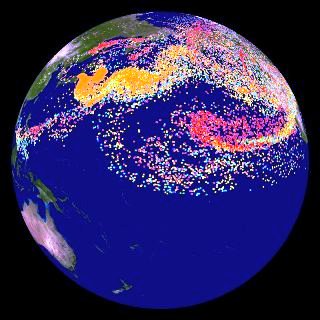The Air Resources Laboratory (ARL) has provided a HYbrid Single- Particle Lagrangian Integrated Trajectory (HYSPLIT) model simulation of the cesium emissions from the Fukushima Daiichi nuclear power plant accident to NOAA for use on its Science On a Sphere® (SOS®). The SOS® is a room size, global display system that uses computers and video projectors to display planetary data onto a six foot diameter sphere. Researchers at NOAA developed SOS® as an educational tool to help illustrate Earth System science to people of all ages. Animated images, such as the one provided by ARL, are shown on the sphere to explain complex environmental processes in a captivating way.
The simulation (snapshot image on right) made available to SOS® shows a continuous release of tracer particles at a rate of 100 per hour representing the Cesium-137 emitted from Fukushima Daiichi. Each change in particle color (red, orange, yellow, cyan, green, blue, violet, magenta) represents a decrease in radioactivity by a factor of 10. Radioactivity decreases only due to wet (precipitation) and dry deposition. Decay is not a factor for Cesium in this short duration simulation compared to its long-half life. Emissions occurred from 12-31 March, 2011, but the particles are followed through the end of April using meteorological data from the 1-degree resolution NOAA global analyses. The maximum cesium emissions on March 15th are shown by the red color and these levels occurred primarily over Japan. By the time the particles reached the United States, air concentrations were 1000 times lower, representing a radiation exposure well below the natural background levels.

Background: The HYSPLIT model is a complete system for computing both simple air parcel trajectories and complex dispersion and deposition simulations. ARL researchers developed, continually improve, and conduct tests with the model for emergency response applications, including nuclear accidents. Due to its research modeling of the Fukushima accident, ARL was given the opportunity to highlight a simulation for SOS®. The SOS® is available to any institution and is currently in operation at a number of facilities in the US and around the world.
Significance: The accidental or intentional release of chemical, biological or nuclear agents can have significant health, safety, security, economic, and ecological implications. The HYSPLIT model is a tool that helps explain how, when, and where materials, such as radioactive cesium, are atmospherically transported, dispersed, and deposited. Having this understanding is essential for helping emergency managers evacuate the right people and for helping develop targeted policies and plans to mitigate problems. There has been public interest in learning more about the Fukushima Daiichi nuclear power plant accident. Having this animation on SOS® increases public understanding of the incident and of NOAA’s capabilities to study atmospheric transport and dispersion of potentially harmful material.

